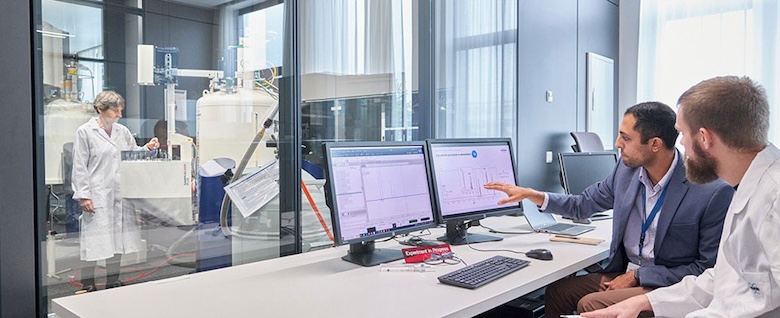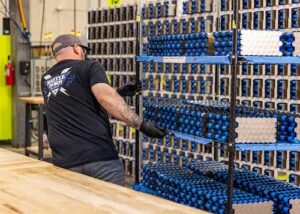Domestic Lithium RV Batteries: Paving the Way Toward a Safer, More Independent Future
Shifting to American-made lithium batteries benefits customers, business and the U.S. economy.

As RV ownership continues its surge in popularity among diverse audiences, the demand for improvements in efficiency and reliability in the vehicle’s sources of power has reached a fever pitch.
In fact, industry reports show that the 2023 RV battery market was valued at $10.4 billion and is expected to reach $32.7 billion by the end of 2030 — representing a compounded annual growth rate (CAGR) of almost 219%.
Technological advancements have paved the way for lithium iron phosphate (LiFePO4) batteries to emerge as an eco-friendly choice for RV energy storage. Lithium-ion batteries have changed the RV battery landscape due to their increased energy density, extended life span, improved safety, temperature tolerance and faster charging capabilities.
The problem? China has a stranglehold on battery production, leaving the battery market potentially dependent on Chinese manufacturers and suppliers. Bloomberg reports that China’s battery makers supply some 80% of cells worldwide, backed by a mining and processing supply chain that increasingly resides in that country’s hands.
Economic & National Security Risks
Chinese dominance of the lithium battery market represents a significant challenge to the United States’ economy. Given exponential increases in demand — a U.S. Department of Energy Industry Report projects that the market for lithium battery cells in the U.S. will expand 500% to reach $55 billion per year by 2030 — the U.S. domestic economy should benefit. Yet it’s estimated that under current conditions, U.S. companies and U.S. workers will capture less than 30% of the value of lithium battery cells consumed domestically. In contrast, China captures 90% of the value of each lithium battery cell consumed in China.
 So, despite massive growth in lithium battery demand, the U.S. remains import-dependent, relying on a global lithium battery supply chain that is highly vulnerable to disruption.
So, despite massive growth in lithium battery demand, the U.S. remains import-dependent, relying on a global lithium battery supply chain that is highly vulnerable to disruption.
Additionally, there’s a risk to our national security. Lawmakers, defense officials and national security experts are calling for increased measures to protect against potential cyberespionage related to foreign-made technologies, according to an article in the Atlantic Council. Energy storage systems like batteries have the potential to collect, transmit and store sensitive information, including biometric data like fingerprints and voice recordings, vehicle location, sensor data and images, financial information and vehicle information. These foreign-made technologies could potentially enable the Chinese government or other foreign organizations to access sensitive personal data of Americans and insight into critical U.S. infrastructure, presenting unacceptable national security risks.
The Domestic Lithium Battery Solution
 Major players in the battery landscape are racing to be the first with a solution to shore up the production process here in the U.S. The challenge has been finding a sustainable solution to domestic lithium battery production, honoring local communities’ needs and capabilities, while being widely implementable and cost-effective when producing at the scale the market demands.
Major players in the battery landscape are racing to be the first with a solution to shore up the production process here in the U.S. The challenge has been finding a sustainable solution to domestic lithium battery production, honoring local communities’ needs and capabilities, while being widely implementable and cost-effective when producing at the scale the market demands.
Given that some of the world’s largest lithium deposits are located right here in the U.S., abundant domestic resources are available to propel this important industry shift.
Dry Electrode Manufacturing
One solution is a new, patented technological process developed by Dragonfly Energy in Reno, Nevada. The process involves dry depositing the anode and cathode electrodes during battery manufacturing.
By successfully dry-depositing lithium iron phosphate anode and cathode electrodes, the company has proved it can produce, at scale, American-made lithium battery cells.
The success of the pilot line shows exceptional scalability and reveals performance at a level sufficient to support large-scale production while at the same time being a toxin-free and environmentally friendly process.
Advantages of Dry-Deposition Process
A dry electrode battery manufacturing process serves the overarching mission of reducing the cost of energy storage and establishing a closed-loop domestic supply chain.
 Here are three of the advantages realized in this new process:
Here are three of the advantages realized in this new process:
- Economical and eco-friendly — This process, highlighted by the use of nontoxic solvents, also features a 22% smaller manufacturing footprint, is 25% less energy-intensive and boasts a 9% reduced carbon footprint when compared to conventional manufacturing methods.
- Effectively translates to other applications — This process is chemistry agnostic, meaning it can be applied to diverse uses across a variety of lithium chemistries — including domestically producing nonflammable LiFePO4 storage batteries.
- Space savings — Dragonfly Energy has been able to reduce the manufacturing footprint required to produce lithium-ion battery cells by eliminating the need for large, energy-intensive equipment such as slurry coaters, conveyor dryers and solvent reclamation equipment. This reduction in energy and space is expected to meaningfully reduce the environmental impact of future battery production.
Paving the Way for Improved Processes & Domestic Self-Reliance
The domestic manufacturing of lithium batteries will result in not only the advantages outlined above but also increased economic growth, job creation and enhanced national security.
The lithium battery industry must continue making steps toward producing fully American-made lithium batteries and eliminating reliance on foreign manufacturers.
With demand for lithium batteries skyrocketing, American-made lithium cells will bolster the national economy and shepherd the nation toward energy independence.
Dry electrode manufacturing may be the game-changing solution to a healthy domestic battery pipeline — and to safe, efficient, reliable batteries powering our nation’s RVs.



